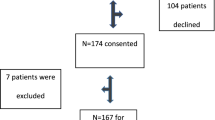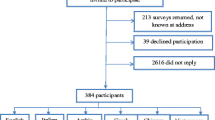Abstract
OBJECTIVE: To determine the association between patient literacy and hospitalization.
DESIGN: Prospective cohort study.
SETTING: Urban public hospital.
PATIENTS: A total of 979 emergency department patients who participated in the Literacy in Health Care study and had completed an intake interview and literacy testing with the Test of Functional Health Literacy in Adults were eligible for this study. Of these, 958 (97.8%) had an electronic medical record available for 1994 and 1995.
MEASUREMENTS AND MAIN RESULTS: Hospital admissions to Grady Memorial Hospital during 1994 and 1995 were determined by the hospital information system. We used multivariate logistic regression to determine the independent association between inadequate functional health literacy and hospital admission. Patients with inadequate literacy were twice as likely as patients with adequate literacy to be hospitalized during 1994 and 1995 (31.5% vs 14.9%, p<.001). After adjusting for age, gender, race, self-reported health, socioeconomic status, and health insurance, patients with inadequate literacy were more likely to be hospitalized than patients with adequate literacy (adjusted odds ratio [OR] 1.69; 95% confidence interval [CI] 1.13, 2.53). The association between inadequate literacy and hospital admission was strongest among patients who had been hospitalized in the year before study entry (OR 3.15; 95% CI 1.45, 6.85).
CONCLUSIONS: In this study population, patients with inadequate functional health literacy had an increased risk of hospital admission.
Similar content being viewed by others
References
Kirsch I, Jungeblut A, Jenkins L, Kolstad A. Adult Literacy in America: A First Look at the Results of the National Adult Literacy Survey. Washington, DC: National Center for Education, US Dept of Education; 1993.
Williams MV, Parker R, Baker D. Inadequate functional health literacy among patients at two public hospitals. JAMA. 1995;274:1677–82.
Baker DW, Parker RM, Williams MV, et al. The health care experience of patients with low literacy. Arch Fam Med. 1996;5:329–34.
Powers RD. Emergency department patient literacy and the readability of patient-directed materials. Ann Emerg Med. 1988;17:124–6.
Doak L, Doak C. Patient comprehension profiles: recent findings and strategies. Patient Couns Health Educ. 1980;2:101–6.
Grundner T. On the readability of surgical consent forms. N Engl J Med. 1980;302:900–2.
Leichter S, Nieman J, Moore R, Collins P, Rhodes A. Readability of self-care instructional pamphlets for diabetic patients. Diabetes Care. 1981;4:627–30.
Holcomb C. Reading difficulty of informational materials from a health maintenance organization. J Reading. 1981;25:130–2.
Boyd M, Citro K. Cardiac patient education literature: can patients read what we give them? J Card Rehab. 1983;3:513–6.
McNeal B, Salisbury Z, Baumgardner P, Wheeler F. Comprehension assessment of diabetes education program participants. Diabetes Care. 1984;7:232–5.
Jaycox S. Smoking literature and literacy levels. Am J Public Health. 1989;79:1058. Letter.
Davis T, Crouch M, Willis G, Miller S, Abdehou D. The gap between patient reading comprehension and the readability of patient education materials. J Fam Pract. 1990;31:533–8.
Jackson R, Davis T, Bairnsfather L, George R, Crouch M, Gault H. Patient reading ability: an overlooked problem in health care. South Med J. 1991;84:1172–5.
Davis T, Mayeaux E, Fredrickson D, Bocchini J, Jackson R, Murphy P. Reading ability of parents compared with reading level of pediatric patient education materials. Pediatrics. 1994;93:460–8.
Jolly B, Scott J, Feied C, Sanford S. Functional illiteracy among emergency department patients: a preliminary study. Ann Emerg Med. 1993;22:573–8.
Spandorfer J, Karras D, Hughes L, Caputo C. Comprehension of discharge instructions by patients in an urban emergency department. Ann Emerg Med. 1995;25:71–4.
Williams MV, Baker DW, Parker RM. Differences in disease knowledge between patients with adequate and inadequate functional health literacy. Arch Intern Med. 1998;158:166–72.
Kitagawa EM, Hauser PM. Differential Mortality in the United States: A Study in Socioeconomic Epidemiology. Cambridge, Mass: Harvard University Press; 1973.
Guralnik JM, Land KC, Blazer D, Fillenbaum GG, Branch LG. Educational status and active life expectancy among older blacks and whites. N Engl J Med. 1993;329:110–6.
Feldman JJ, Makuc DM, Kleinman JC, Cornoni-Huntley J. National trends in educational differentials in mortality. Am J Epidemiol. 1989;129:919–33.
Hurowitz JC. Toward a social policy for health. N Engl J Med. 1993;329:130–3.
Nelson MD Jr. Socioeconomic status and childhood mortality in North Carolina. Am J Public Health. 1992;82:1131–3.
Tofler GH, Muller JE, Stone PH, Davies G, Davis VG, Braunwald E. Comparison of long-term outcome after acute myocardial infarction in patients never graduated from high school with that in more educated patients. Multicenter Investigation Limitation Infarct Size (MILIS). Am J Cardiol. 1993;71:1031–5.
Keil JE, Sutherland SE, Knapp RG, Lackland DT, Gazes PC, Tyroler HA. Mortality rates and risk factors for coronary disease in black as compared with white men and women. N Engl J Med. 1993;329:73–8.
Stamler R, Hardy RJ, Payne GH. Educational level and five-year all-cause mortality in the hypertension detection and follow-up program. Hypertension. 1987;9:641–6.
Parikh NS, Parker RM, Nurss JR, Baker DW, Williams MV. Shame and health literacy: the unspoken connection. Patient Educ Counseling. 1996;27:33–9.
Davis TC, Long SW, Jackson RH, et al. Rapid estimate of adult literacy in medicine: a shortened screening instrument. Fam Med. 1993;25:391–5.
Kuh D, Stirling S. Socioeconomic variation in admission for disease of female genital system and breast in a national cohort aged 15–43. BMJ. 1995;311:840–3.
Weiss BD, Blanchard JS, McGee DL, et al. Illiteracy among Medicaid recipients and its relationship to health care costs. J Health Care Poor Underserved. 1994;5:99–111.
Baker DW, Parker RM, Williams MV, Clark WS, Nurss JR. The relationship of patient reading ability to self-reported health and use of health services. Am J Public Health. 1997;87:1027–30.
Parker RM, Baker DW, Williams MV, Nurss JR. The Test of Functional Health Literacy in Adults (TOFHLA): a new instrument for measuring patient’s literacy skills. J Gen Intern Med. 1995;10:537–42.
Taylor W. Cloze procedure: a new tool for measuring readability. Journalism Q. 1953;30:415–33.
Ware JE. SF-36 Health Survey: Manual and Interpretation Guide. Boston, Mass: The Health Institute, New England Medical Center; 1993.
Stewart AL, Greenfield S, Hays RD, et al. Functional status and well-being of patients with chronic conditions: results from the Medical Outcomes Study. JAMA. 1989;262:907–13.
Prevalence of selected risk factors for chronic disease by education level in racial/ethnic populations—United States, 1991–1992. MMWR. 1995;1004:894–9.
Health Care Financing Review: Medicare and Medicaid Statistical Supplement, 1995. Baltimore, Md: Health Care Financing Administration; 1996.
Hussey LC. Minimizing effects of low literacy on medication knowledge and compliance among the elderly. Clin Nurs Res. 1994;3:132–45.
Revell L. Understanding, identifying, and teaching the low-literacy patient. Semin Periop Nurs. 1994;3:168–71.
Berger D, Inkelas M, Myhre S, Mishler A. Developing health education materials for inner-city low literacy parents. Public Health Rep. 1994;109:168–72.
Plimpton S, Root J. Materials and strategies that work in low literacy health communication. Public Health Rep. 1994;109:86–92.
Meade CD, McKinney WP, Barnas GP. Educating patients with limited literacy skills: the effectiveness of printed and videotaped materials about colon cancer. Am J Public Health. 1994;84:119–21.
Brown P, Ames N, Mettger W, et al. Closing the comprehension gap: low literacy and the Cancer Information Service. Monogr Natl Cancer Inst. 1993;157–63.
Overland JE, Hoskins PL, McGill MJ, Yue DK. Low literacy: a problem in diabetes education. Diabetic Med. 1993;10:847–50.
Weiss BD. Identifying and communicating with patients who have poor literacy skills. Fam Med. 1993;25:369–70.
Hussey LC. Overcoming the clinical barriers of low literacy and medication noncompliance among the elderly. J Gerontol Nurs. 1991;17:27–9.
Doak CC, Doak LG, Root JH. Teaching Patients with Low Literacy Skills. 2nd ed. Philadelphia, Pa: J.B. Lippincott; 1996.
Said MB, Consoli S, Jean J. A comparative study between a computer-aided education (ISIS) and habitual education techniques for hypertensive patients. J Am Med Inform Assoc. 1994; (symp suppl): 10–14.
Michielutte R, Bahnson J, Dignan M, Schroeder E. The use of illustrations and narrative text style to improve readability of a health education borchure. J Cancer Educ. 1992;7:251–60.
McCabe B, Tysinger JW, Kreger M, Currwin A. A strategy for designing effective patient education materials. J Am Diet Assoc. 1989;89:1290–5.
Author information
Authors and Affiliations
Rights and permissions
About this article
Cite this article
Baker, D.W., Parker, R.M., Williams, M.V. et al. Health literacy and the risk of hospital admission. J GEN INTERN MED 13, 791–798 (1998). https://doi.org/10.1046/j.1525-1497.1998.00242.x
Issue Date:
DOI: https://doi.org/10.1046/j.1525-1497.1998.00242.x




